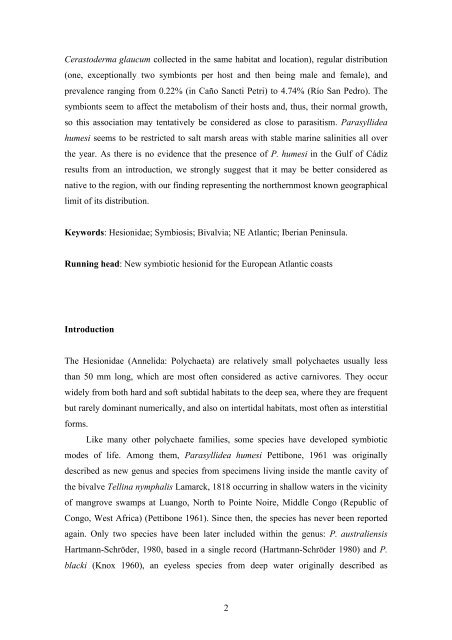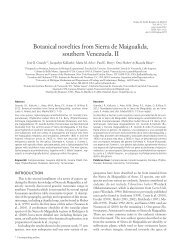Versió d'autor P Hume... - CSIC
Versió d'autor P Hume... - CSIC
Versió d'autor P Hume... - CSIC
You also want an ePaper? Increase the reach of your titles
YUMPU automatically turns print PDFs into web optimized ePapers that Google loves.
Cerastoderma glaucum collected in the same habitat and location), regular distribution<br />
(one, exceptionally two symbionts per host and then being male and female), and<br />
prevalence ranging from 0.22% (in Caño Sancti Petri) to 4.74% (Río San Pedro). The<br />
symbionts seem to affect the metabolism of their hosts and, thus, their normal growth,<br />
so this association may tentatively be considered as close to parasitism. Parasyllidea<br />
humesi seems to be restricted to salt marsh areas with stable marine salinities all over<br />
the year. As there is no evidence that the presence of P. humesi in the Gulf of Cádiz<br />
results from an introduction, we strongly suggest that it may be better considered as<br />
native to the region, with our finding representing the northernmost known geographical<br />
limit of its distribution.<br />
Keywords: Hesionidae; Symbiosis; Bivalvia; NE Atlantic; Iberian Peninsula.<br />
Running head: New symbiotic hesionid for the European Atlantic coasts<br />
Introduction<br />
The Hesionidae (Annelida: Polychaeta) are relatively small polychaetes usually less<br />
than 50 mm long, which are most often considered as active carnivores. They occur<br />
widely from both hard and soft subtidal habitats to the deep sea, where they are frequent<br />
but rarely dominant numerically, and also on intertidal habitats, most often as interstitial<br />
forms.<br />
Like many other polychaete families, some species have developed symbiotic<br />
modes of life. Among them, Parasyllidea humesi Pettibone, 1961 was originally<br />
described as new genus and species from specimens living inside the mantle cavity of<br />
the bivalve Tellina nymphalis Lamarck, 1818 occurring in shallow waters in the vicinity<br />
of mangrove swamps at Luango, North to Pointe Noire, Middle Congo (Republic of<br />
Congo, West Africa) (Pettibone 1961). Since then, the species has never been reported<br />
again. Only two species have been later included within the genus: P. australiensis<br />
Hartmann-Schröder, 1980, based in a single record (Hartmann-Schröder 1980) and P.<br />
blacki (Knox 1960), an eyeless species from deep water originally described as<br />
2
















